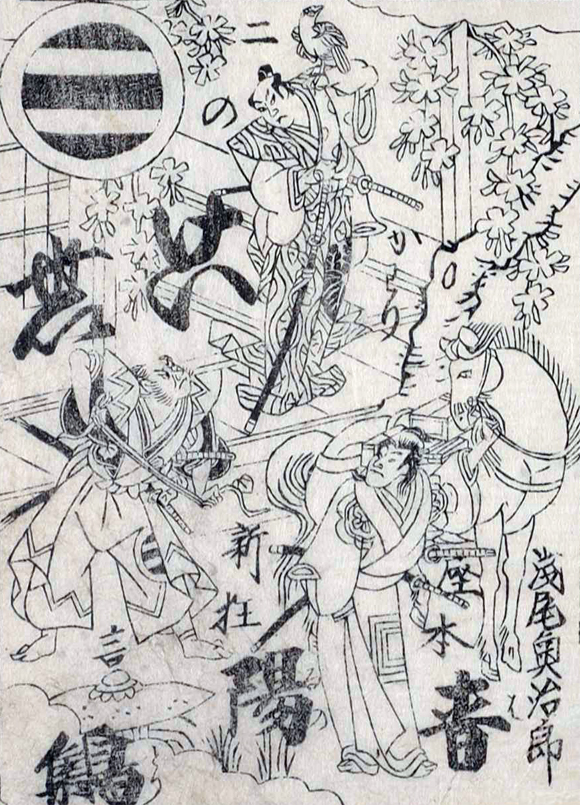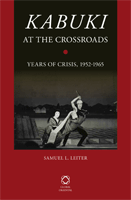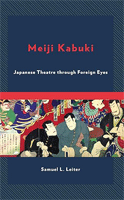| KEISEI HARU NO TORI |
| Play titles | Keisei Haru no Tori Sanzen Ry˘ Kogane no Kurairi Sanzen Ry˘ Haru no Komahiki |
|||
| Authors | Tatsuoka Mansaku (tatesakusha) Chikamatsu Tokus˘, Nagawa Shimesuke I (sakusha) |
|||
| History |
Tatsuoka Mansaku's drama "Keisei Haru no Tori" was premiered in the 1st lunar month of 1794, in ďsaka at the Kado no Shibai [more details]. It was famous for its "Umagiri" scene in which a young samurai slayed a horseman to steal a horse holding 3000 ry˘ in a wooden chest. The hero of this scene was meant to be Matsudaira Ch˘shichir˘, (most likely) the son of Tokugawa Tadanaga who was forced to commit seppuku by his elder brother Tokugawa Iemitsu, the 3rd Tokugawa Shogun! In order to avoid the strict censorship by the ruling Tokugawa Shogunate, the playwrights used the Taik˘ki sekai with Matsudaira Ch˘shichir˘ being turned into Oda Sanshichir˘ Nobutaka, the son of Oda Nobunaga (Oda Harunaga in the drama). In October 1898, the "Umagiri" scene was turned into an independent drama which was entitled "Sanzen Ry˘ Kogane no Kurairi" and which was staged in T˘ky˘ at the Miyatoza. In this drama, the hero was finally Matsudaira Ch˘shichir˘! It was played by Ichimura Kakitsu VI. Later, this role became an important role of the Kataoka clan and it was included in the Kataoka Jűnishű collection of roles. In January 2014, there was the premiere at the National Theatre of "Sanzen Ry˘ Haru no Komahiki", a revival with new elements of Tatsuoka Mansaku's 1794 drama "Keisei Haru no Tori" in which the hero was Oda Sanshichir˘ Nobutaka, not Matsudaira Ch˘shichir˘ [more details]. |
|||
| Structure |
The original drama "Keisei Haru no Tori" was in 7 acts, divided into 23 scenes. The 2014 revival "Sanzen Ry˘ Haru no Komahiki" was in 6 acts, divided into 9 scenes. The "Umagiri" scene is still part of the current Kabuki repertoire. |
|||
| Key words |
Kataoka Jűnishű Kii K˘rai K˘yasan Kuruwa Mashiba Hisayoshi Matsudaira Ch˘shichir˘ Ni-no-Kawari Oda Harunaga Ry˘ Seppuku Shinjű Shinjűmono Shinmachi Tachimawari Tokugawa Iemitsu Tokugawa Tadanaga Tsuri Tenj˘ Umagiri |
|||
| Summary |
The play represents the political situation following the overthrow of Akechi Mitsuhide by Mashiba Hisayoshi, who himself wrested power from Oda Harunaga. Kanai Sankur˘ and the Korean lord Kan Ch˘kai [1] begin a conspiracy which is the seed of the action that follows. Shibata Katsushige, hidden in a suspended ceiling, attempts to assassinate Mashiba Hisayoshi and Oda Sanb˘shimaru, whom he is protecting, but the plot is perceived by Miwa Gorozaemon Takahide, and the would-be assassin kills himself. This exposes Kanai and Kan Ch˘kai's conspiracy. Katsushige's adoptive father, Iruma Yosodayű, is soon attacked by Oda's faction. Meanwhile, Harunaga's son, Oda Sanshichir˘ Nobutaka, plunges into a life of dissipation in ďsaka's Shinmachi quarters, where he racks up steep debts. He then hears that Hisayoshi is sending 3,000 ry˘ to Mount K˘ya to honor Oda Harunaga's memory in a mortuary temple. At Yamato Bridge in Sakai, with a single slash, Nobutaka cuts down a horseman bearing the money and escapes with the 3,000 ry˘. (This is the "Umagiri" section, also called "Yamato Bashi.") It turns out that the man was a samurai formerly in service to Oda Harunaga, but who turned traitor and was going to keep the money for himself. The police learn of the incident and surround Nobutaka. Realizing who he is, though, they at once prostrate themselves out of respect. Later, it is revealed that his dissipation was actually a ruse designed to allow his son, Sanb˘shimaru, to succeed to the family headship while he, Nobutaka, searched for an heirloom sword. Moreover, the 3,000 ry˘, it turns out, were secretly intended by Hisayoshi to support Nobutaka. Other plot developments involve Katsushige's brother, the lumber wholesaler Tarosuke, who has become a townsman, and the latter's mistress, who commit double suicide as recompense for Katsushige's behavior. Kanai Sankur˘'s death ends the play.
|
|||
| Notes |
[1] His title in this play was K˘rai-no-Kuni-no-Kami, the kami of the Kingdom of Goryeo. |
 |
|
The cover of the ezukushi banzuke for the staging of the drama "Keisei Haru no Tori" in the 1st lunar month of 1794 in ďsaka at the Kado no Shibai |
|
|
| Contact | Main | Top | Updates | Actors | Plays | Playwrights | Programs | Links | FAQ | Glossary | Chronology | Illustrations | Prints | Characters | Derivatives | Theaters | Coming soon | News |


